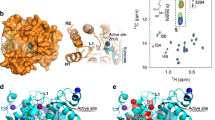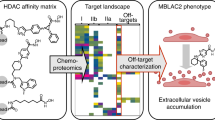Abstract
The broad study of histone deacetylases in chemistry, biology and medicine relies on tool compounds to derive mechanistic insights. A phylogenetic analysis of class I and II histone deacetylases (HDACs) as targets of a comprehensive, structurally diverse panel of inhibitors revealed unexpected isoform selectivity even among compounds widely perceived as nonselective. The synthesis and study of a focused library of cinnamic hydroxamates allowed the identification of, to our knowledge, the first nonselective HDAC inhibitor. These data will guide a more informed use of HDAC inhibitors as chemical probes and therapeutic agents.
This is a preview of subscription content, access via your institution
Access options
Subscribe to this journal
Receive 12 print issues and online access
$259.00 per year
only $21.58 per issue
Buy this article
- Purchase on Springer Link
- Instant access to full article PDF
Prices may be subject to local taxes which are calculated during checkout




Similar content being viewed by others
References
Minucci, S. & Pelicci, P.G. Histone deacetylase inhibitors and the promise of epigenetic (and more) treatments for cancer. Nat. Rev. Cancer 6, 38–51 (2006).
Lee, K.K. & Workman, J.L. Histone acetyltransferase complexes: one size doesn′t fit all. Nat. Rev. Mol. Cell Biol. 8, 284–295 (2007).
Choudhary, C. et al. Lysine acetylation targets protein complexes and co-regulates major cellular functions. Science 325, 834–840 (2009).
Gregoretti, I.V., Lee, Y.M. & Goodson, H.V. Molecular evolution of the histone deacetylase family: functional implications of phylogenetic analysis. J. Mol. Biol. 338, 17–31 (2004).
Smith, B.C., Hallows, W.C. & Denu, J.M. Mechanisms and molecular probes of sirtuins. Chem. Biol. 15, 1002–1013 (2008).
Sternson, S.M., Wong, J.C., Grozinger, C.M. & Schreiber, S.L. Synthesis of 7200 small molecules based on a substructural analysis of the histone deacetylase inhibitors trichostatin and trapoxin. Org. Lett. 3, 4239–4242 (2001).
Bowers, A.A. et al. Synthesis and conformation-activity relationships of the peptide isosteres of FK228 and largazole. J. Am. Chem. Soc. 131, 2900–2905 (2009).
Bolden, J.E., Peart, M.J. & Johnstone, R.W. Anticancer activities of histone deacetylase inhibitors. Nat. Rev. Drug Discov. 5, 769–784 (2006).
Jones, P. et al. Probing the elusive catalytic activity of vertebrate class IIa histone deacetylases. Bioorg. Med. Chem. Lett. 18, 1814–1819 (2008).
Zhou, X., Richon, V.M., Rifkind, R.A. & Marks, P.A. Identification of a transcriptional repressor related to the noncatalytic domain of histone deacetylases 4 and 5. Proc. Natl. Acad. Sci. USA 97, 1056–1061 (2000).
Parra, M., Kasler, H., McKinsey, T.A., Olson, E.N. & Verdin, E. Protein kinase D1 phosphorylates HDAC7 and induces its nuclear export after T-cell receptor activation. J. Biol. Chem. 280, 13762–13770 (2005).
Mottet, D. et al. Histone deacetylase 7 silencing alters endothelial cell migration, a key step in angiogenesis. Circ. Res. 101, 1237–1246 (2007).
Renthal, W. et al. Histone deacetylase 5 epigenetically controls behavioral adaptations to chronic emotional stimuli. Neuron 56, 517–529 (2007).
Tsankova, N.M. et al. Sustained hippocampal chromatin regulation in a mouse model of depression and antidepressant action. Nat. Neurosci. 9, 519–525 (2006).
Bolger, T.A. & Yao, T.P. Intracellular trafficking of histone deacetylase 4 regulates neuronal cell death. J. Neurosci. 25, 9544–9553 (2005).
Cohen, T.J. et al. The histone deacetylase HDAC4 connects neural activity to muscle transcriptional reprogramming. J. Biol. Chem. 282, 33752–33759 (2007).
Bowers, A. et al. Total synthesis and biological mode of action of largazole: a potent class I histone deacetylase inhibitor. J. Am. Chem. Soc. 130, 11219–11222 (2008).
Riester, D., Wegener, D., Hildmann, C. & Schwienhorst, A. Members of the histone deacetylase superfamily differ in substrate specificity towards small synthetic substrates. Biochem. Biophys. Res. Commun. 324, 1116–1123 (2004).
Lahm, A. et al. Unraveling the hidden catalytic activity of vertebrate class IIa histone deacetylases. Proc. Natl. Acad. Sci. USA 104, 17335–17340 (2007).
Wong, J.C., Sternson, S.M., Louca, J.B., Hong, R. & Schreiber, S.L. Modular synthesis and preliminary biological evaluation of stereochemically diverse 1,3-dioxanes. Chem. Biol. 11, 1279–1291 (2004).
Vegas, A.J. et al. Fluorous-based small-molecule microarrays for the discovery of histone deacetylase inhibitors. Angew. Chem. Int. Edn Engl. 46, 7960–7964 (2007).
Patel, V. et al. Identification and characterization of small molecule inhibitors of a class I histone deacetylase from Plasmodium falciparum. J. Med. Chem. 52, 2185–2187 (2009).
Wang, D., Helquist, P. & Wiest, O. Zinc binding in HDAC inhibitors: a DFT study. J. Org. Chem. 72, 5446–5449 (2007).
Schuetz, A. et al. Human HDAC7 harbors a class IIa histone deacetylase-specific zinc binding motif and cryptic deacetylase activity. J. Biol. Chem. 283, 11355–11363 (2008).
Bottomley, M.J. et al. Structural and functional analysis of the human HDAC4 catalytic domain reveals a regulatory structural zinc-binding domain. J. Biol. Chem. 283, 26694–26704 (2008).
Mujtaba, S., Zeng, L. & Zhou, M.M. Structure and acetyl-lysine recognition of the bromodomain. Oncogene 26, 5521–5527 (2007).
Katoh, K., Kuma, K., Toh, H. & Miyata, T. MAFFT version 5: improvement in accuracy of multiple sequence alignment. Nucleic Acids Res. 33, 511–518 (2005).
Katoh, K., Misawa, K., Kuma, K. & Miyata, T. MAFFT: a novel method for rapid multiple sequence alignment based on fast Fourier transform. Nucleic Acids Res. 30, 3059–3066 (2002).
Katoh, K. & Toh, H. Recent developments in the MAFFT multiple sequence alignment program. Brief. Bioinform. 9, 286–298 (2008).
Wang, L.S. et al. The impact of multiple protein sequence alignment on phylogenetic estimation. in IEEE/ACM Transactions on Computational Biology and Bioinformatics (IEEE Computer Society, 2009) 〈http://doi.ieeecomputersociety.org/10.1109/TCBB.2009.68〉.
Stamatakis, A., Hoover, P. & Rougemont, J. A rapid bootstrap algorithm for the RAxML Web servers. Syst. Biol. (Stevenage) 57, 758–771 (2008).
Acknowledgements
We thank S. Schreiber and the Broad Chemical Biology Program for research space and support. We thank J. Clardy, T. Mitchison, R. Weissleder, O. Wiest, R. Williams (Colorado State University), T. Lewis (Broad Institute) and R. Maglathlin (Broad Institute) for support, thoughtful discussions and access to key instrumentation and reagents. We thank A. Stamatakis for helpful discussions on phylogenetics. We thank C. Johnson, G. Beletsky and S. Jonston for analytical support. This work was supported by grants from the US National Cancer Institute (1K08CA128972; J.E.B.), the American Society of Hematology (J.E.B.), the Multiple Myeloma Research Foundation (J.E.B.), the Burroughs-Wellcome Foundation (J.E.B.), the US National Institutes of Health (T32CA079443 to M.L.G., 1R01DA028301-01 to S.J.H. and P01CA078048 to R.M.), and the US National Science Foundation (DEB 0733029 and ITR 0331453 to T.W.). The project has been funded in part with funds from the US National Cancer Institute's Initiative for Chemical Genetics (contract number N01-CO-12400). The content of this publication does not necessarily reflect the views or policies of the US Department of Health and Human Services, nor does the mention of trade names, commercial products or organizations imply endorsement by the US government.
Author information
Authors and Affiliations
Contributions
J.E.B. developed biochemical methods, analyzed data, designed and synthesized the cinnamic hydroxmate library, provided research funding, supervised, prepared the manuscript and mentored N.W., M.L.G. and E.F.G. N.W. developed the class IIa biochemical methods, analyzed data and synthesized pandacostat. M.L.G. synthesized and purified pandacostat and analyzed data. E.F.G. developed the class I and IIb biochemical methods and analyzed data. S.J.H. designed experiments and provided reagents. T.W. advised on phylogenetic analysis. R.M. designed and synthesized substrates and tool HDAC inhibitors, synthesized the cinnamic hydroxmate library, developed methods, analyzed data, provided research funding, prepared the manuscript, and mentored M.L.G. The corresponding authors (J.E.B. and R.M.) certify that all authors have agreed to all the content in the manuscript, including the data as presented.
Corresponding authors
Ethics declarations
Competing interests
J.E.B. and R.M. are scientific founders of and shareholders in SHAPE Pharmaceuticals and Acetylon Pharmaceuticals.
Supplementary information
Supplementary Text and Figures
Supplementary Methods, Supplementary Figures 1–8 and Supplementary Table 1 (PDF 3935 kb)
Rights and permissions
About this article
Cite this article
Bradner, J., West, N., Grachan, M. et al. Chemical phylogenetics of histone deacetylases. Nat Chem Biol 6, 238–243 (2010). https://doi.org/10.1038/nchembio.313
Received:
Accepted:
Published:
Issue Date:
DOI: https://doi.org/10.1038/nchembio.313
This article is cited by
-
Histone 4 lysine 5/12 acetylation enables developmental plasticity of Pristionchus mouth form
Nature Communications (2023)
-
Lactate-dependent transcriptional regulation controls mammalian eye morphogenesis
Nature Communications (2023)
-
Inhibiting stromal Class I HDACs curbs pancreatic cancer progression
Nature Communications (2023)
-
CAR-T cell combination therapy: the next revolution in cancer treatment
Cancer Cell International (2022)
-
Molecular mechanisms of bifunctional vitamin D receptor agonist-histone deacetylase inhibitor hybrid molecules in triple-negative breast cancer
Scientific Reports (2022)



